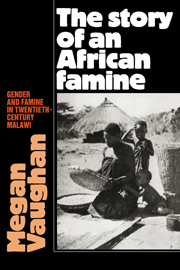Book contents
- Frontmatter
- Contents
- List of maps
- List of illustrations
- Preface
- Glossary
- Introduction
- 1 The 1949 famine
- 2 Famine as a Malthusian crisis
- 3 Famine as a failure of the market
- 4 Food entitlement and employment
- 5 Gender and famine
- 6 After the famine: a conclusion
- Notes
- List of oral interviews
- Bibliography
- Index
- Frontmatter
- Contents
- List of maps
- List of illustrations
- Preface
- Glossary
- Introduction
- 1 The 1949 famine
- 2 Famine as a Malthusian crisis
- 3 Famine as a failure of the market
- 4 Food entitlement and employment
- 5 Gender and famine
- 6 After the famine: a conclusion
- Notes
- List of oral interviews
- Bibliography
- Index
Summary
Famines gather history around them. In the Blantyre District of Southern Malawi many people remember the famine which occurred in 1949–50, and many more have been told about it. There are stories and songs and recollections of the famine: accounts of foraging and migration; of ‘famine disease’ and death; of both the cohesion and the disintegration of communities and families; of selflessness and the extremes of individualism. Survivors of the famine can give close accounts of the events of that year. They begin with the abnormal weather conditions – what the clouds looked like and what this meant; how high the crops grew before they died, and which crops survived; the names of the children who starved and the husbands who left; the wild foods eaten and their methods of preparation; the minute details of the famine relief system – the coarseness and the colour of the grain distributed, the size of the tins which acted as measures, the behaviour of the queuing people who waited to receive it. Older people can tell stories of famines that went before – the 1922 famine and the famine of 1903 which drove people into the area from Mozambique. They say that nothing comparable to 1949 has happened since. People calculate their ages by reference to it, and women consciously keep the communal memory of the event alive when they sing the pounding songs they composed then.
- Type
- Chapter
- Information
- The Story of an African FamineGender and Famine in Twentieth-Century Malawi, pp. 1 - 20Publisher: Cambridge University PressPrint publication year: 1987



